Improving representation on B.C.’s boards
May 30, 2025
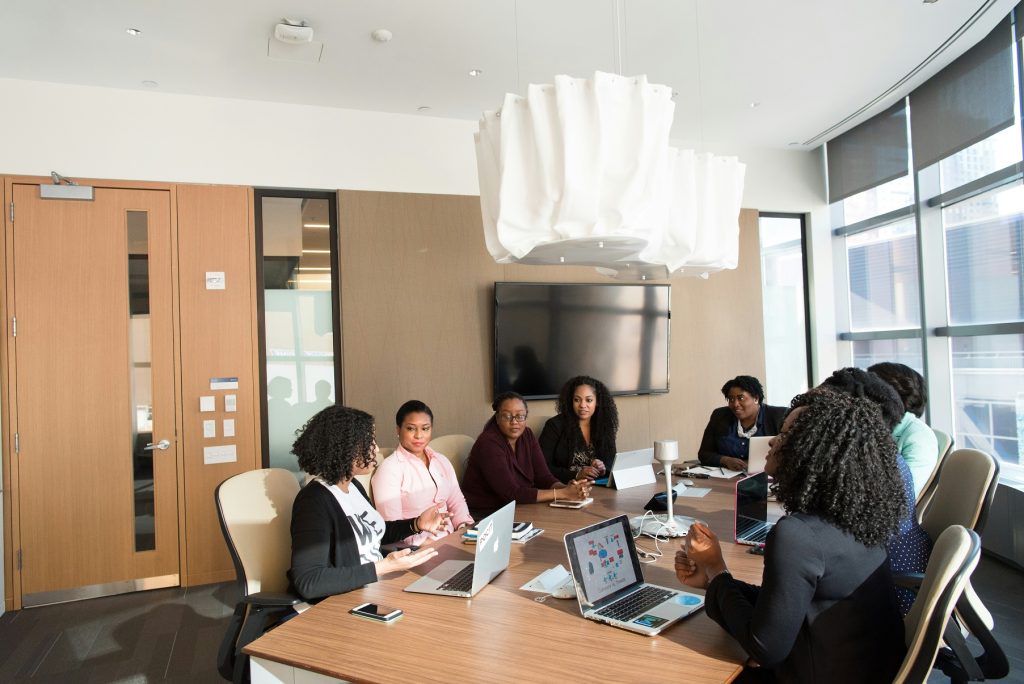
Historically, Indigenous and racialized people and other equity-deserving groups have faced barriers to civic participation in B.C. This has included discriminatory policies that limited their ability to vote or serve as an elected official.
The impact is still felt today, with many of these communities underrepresented on B.C.’s agencies, boards and commissions. These organizations play an essential role in serving people across the province. There are around 230 organizations in B.C.’s public sector. Examples include police boards, health authorities and college boards.
Appointees provide advice and recommendations to help with the oversight and day-to-day operations of these organizations, including service delivery and access to fair dispute resolution processes. Appointment terms are limited and representation will shift over time as individuals join or are reappointed to positions.
As government, we need our work to be shaped by a variety of perspectives, lived experience and expertise. That’s why it’s important that appointees to B.C.’s agencies, boards and commissions reflect the diversity of people across the province. We’ve seen a shift towards more equitable representation over the last few years but there’s clearly ongoing need for improvement.

The research
In 2023, the Province, in collaboration with the Anti Racism Data Committee and Indigenous Peoples identified 10 anti-racism research priorities under the Anti-Racism Data Act. One of these priorities focused on improving racial diversity and equity in the BC Public Service.
To address systemic racism in government services, it’s important that the people guiding our decisions represent communities across B.C. This research into representation among appointees is a step towards this goal.
The Government of B.C.’s Crown Agencies and Board Resourcing Office (CABRO) oversees the process for appointing individuals to B.C.’s agencies, boards and commissions. In May 2024, CABRO carried out a survey to understand representation on B.C.’s agencies, boards and commissions. This survey was sent to all individuals currently in a role that is overseen by CABRO. It did not include individuals serving on a board of directors for an organization under the Societies Act.
Just over 32% of the 1,677 current appointees completed the survey. The sample was representative of the regional distribution of all appointees and had a +/- 3.5% margin of error.
CABRO compared the results to a previous survey from 2020 to see if representation has changed. The team also compared representation on boards to the Census to understand which groups may be over and underrepresented. This approach has limitations, but it was the most reliable population benchmark available at the time.
This information will help to identify opportunities to improve representation of Indigenous, racialized and other underrepresented communities.

What we learned
In 2024, we saw some positive shifts compared to 2020, including:
- More equitable distribution across age groups, with a decrease to the number of appointees aged 55+ and an increase in those aged 35-54
- The number of appointees identifying as Black more than tripled
- The share of people identifying as LGBTQ+ grew by 1.5 times
- The percent of appointees reporting a disability more than doubled
However, some groups continue to be underrepresented on B.C.’s agencies, boards and commissions. This includes people:
- Who identify as Chinese or Filipino
- With disabilities
- Who are caregivers for adults or children
- Between the age of 18-34
- Living in the Lower Mainland/Southwest and Thompson-Okanagan regions
Indigenous identity
Indigenous appointees are represented at a similar level to the B.C. population:
- Just over 5.5% of appointees identify as First Nations
- Just over 3% identify as Métis
The number of Inuit appointees is low. To protect their identity, this number has not been disclosed. Learn more about the comparison to population data below.
Compared to everyone else in the sample, Indigenous appointees were:
- More likely to be 35-54 years old
- More likely to identify as a woman
- More likely to identify as LGBTQ+*
- More likely to report a disability
- More likely to be caregivers for children under 18 and for adults
These factors are important to consider when creating and filling CABRO positions as well as when supporting current Indigenous appointees.
Indigenous people living in rural and remote areas may face additional barriers to participating in opportunities and may be underrepresented in these positions. While the team did not look at regional differences in representation for this research, it will be considered in future reports.
*Note that Two-Spirit is a specific Indigenous identity. The CABRO survey asked about Two-Spirit identity separately from LGBTQ+ identities. A small number of people identified as Two-Spirit. To protect their identity this number has not been disclosed.
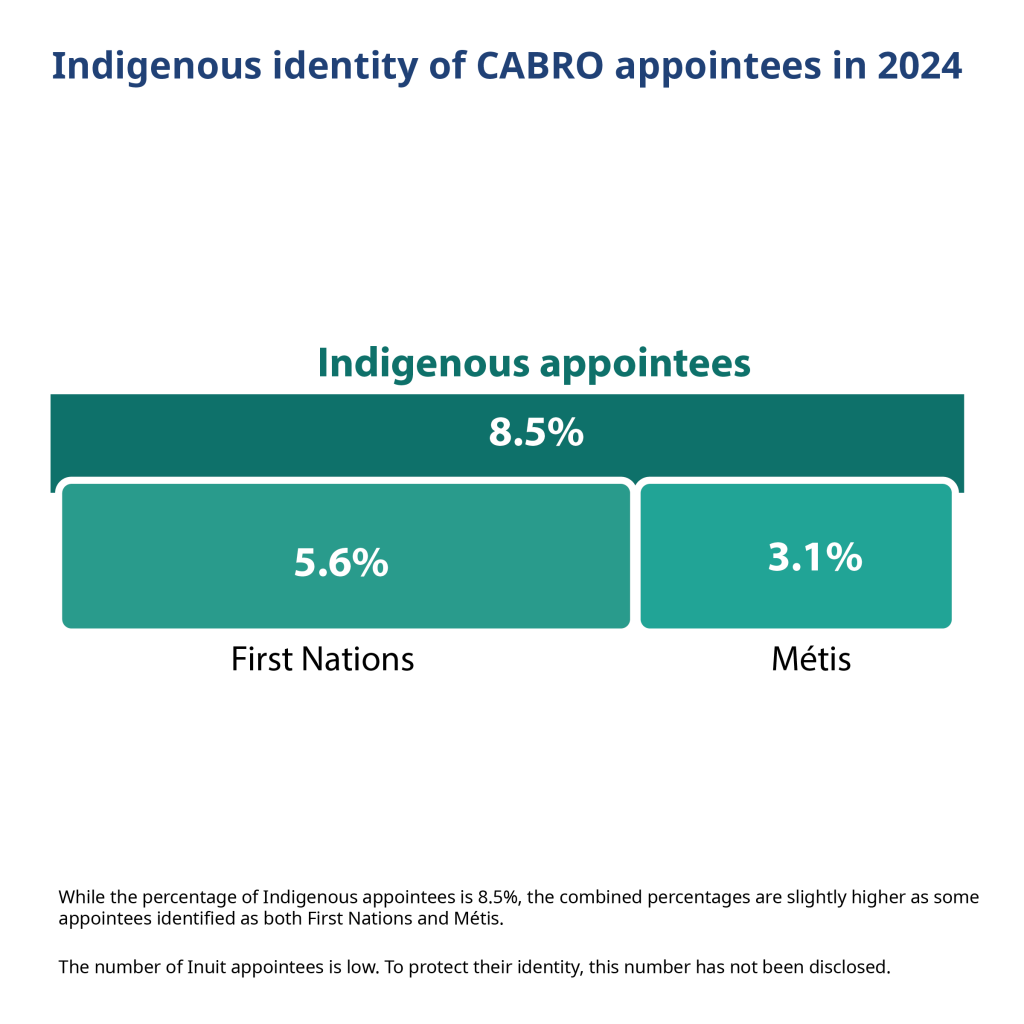
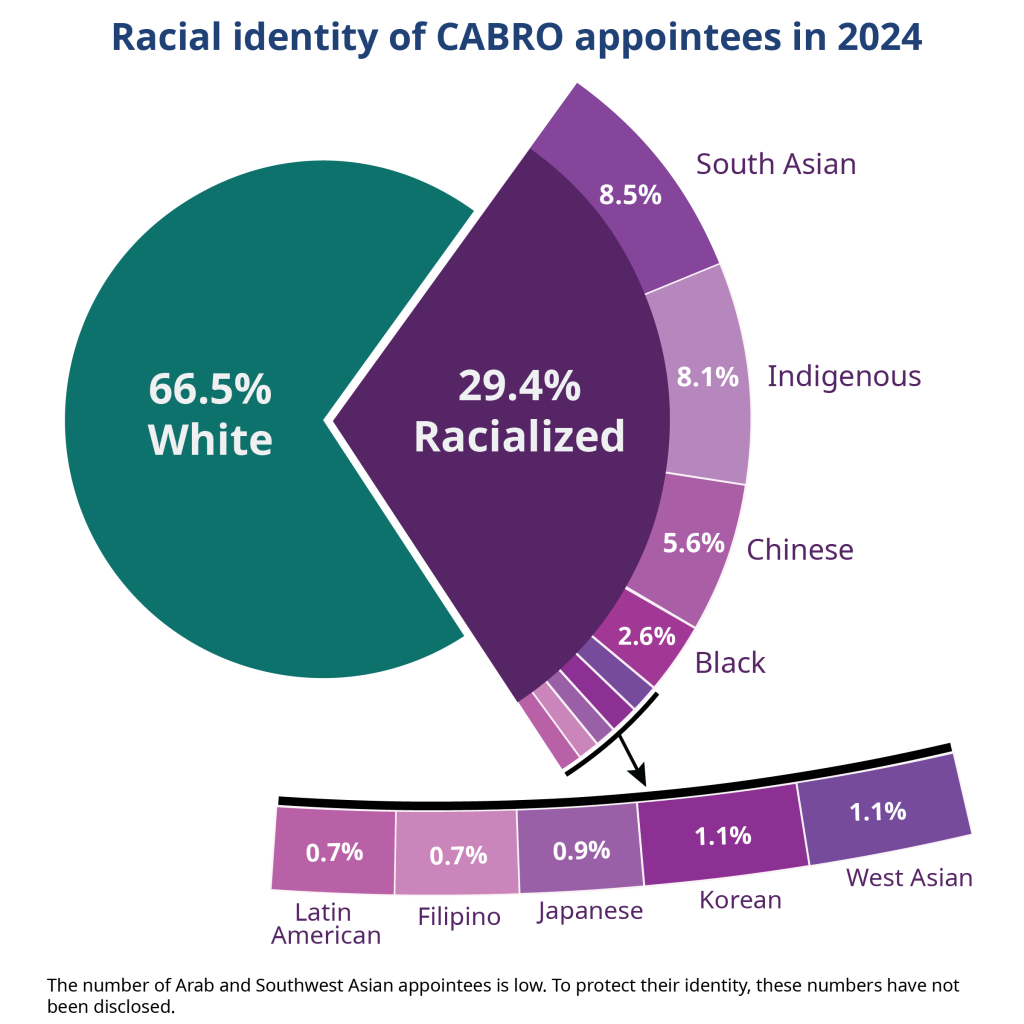
Race
Two-thirds are white and just under a third are racialized
The survey provided 12 options for race or racial background, as well as “Don’t know” and “Prefer not to answer”.
While most racialized groups were represented in line with their share of the B.C. population, those identifying as Chinese and Filipino were represented at lower rates.
To reach census-level representation, the share of Chinese appointees would need to double and the share of Filipino appointees would need to increase by five times.
Racialized appointees in the sample were:
- More likely to be 35-54 years old
- More likely to be comfortable using two languages at work
- More likely to be caregivers for a child under 18 and for an adult
- More likely to live in the Lower Mainland/Southwest region
These are important considerations when creating and filling CABRO positions, as well as when supporting current racialized appointees.
Age
For appointees in 2024:
- 62% are over 55 – compared to 41.8% of the population
- 33% are 35-54 – this is in line with the population
- 3.5% are between 18-34 – compared to 26.4% of the population
Compared to everyone else in the sample, appointees over the age of 55+ were:
- Less likely to identify as First Nations or racialized
- Less likely to identify as LGBTQ+
- Less likely to report a disability
- Less likely to be caregivers of a child under 18
- More likely to live in the Vancouver Island/Coast region
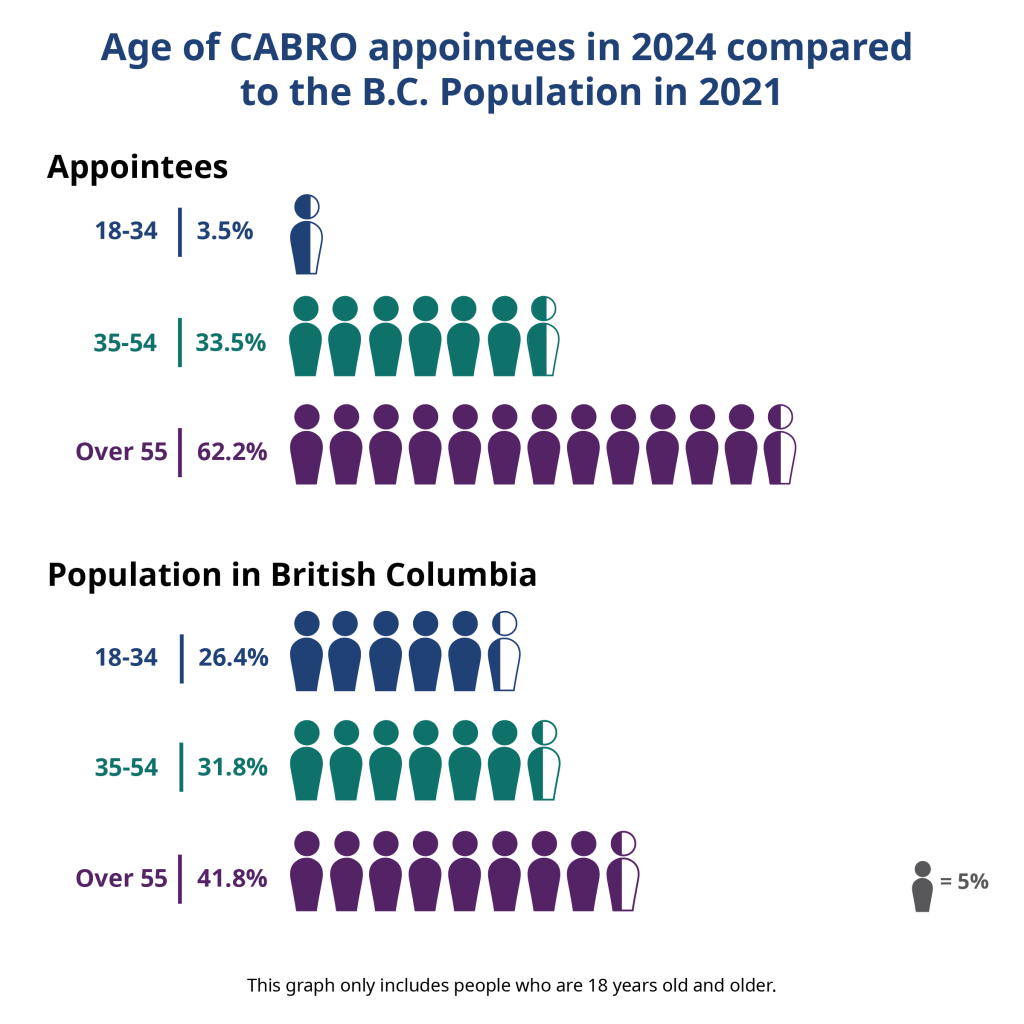
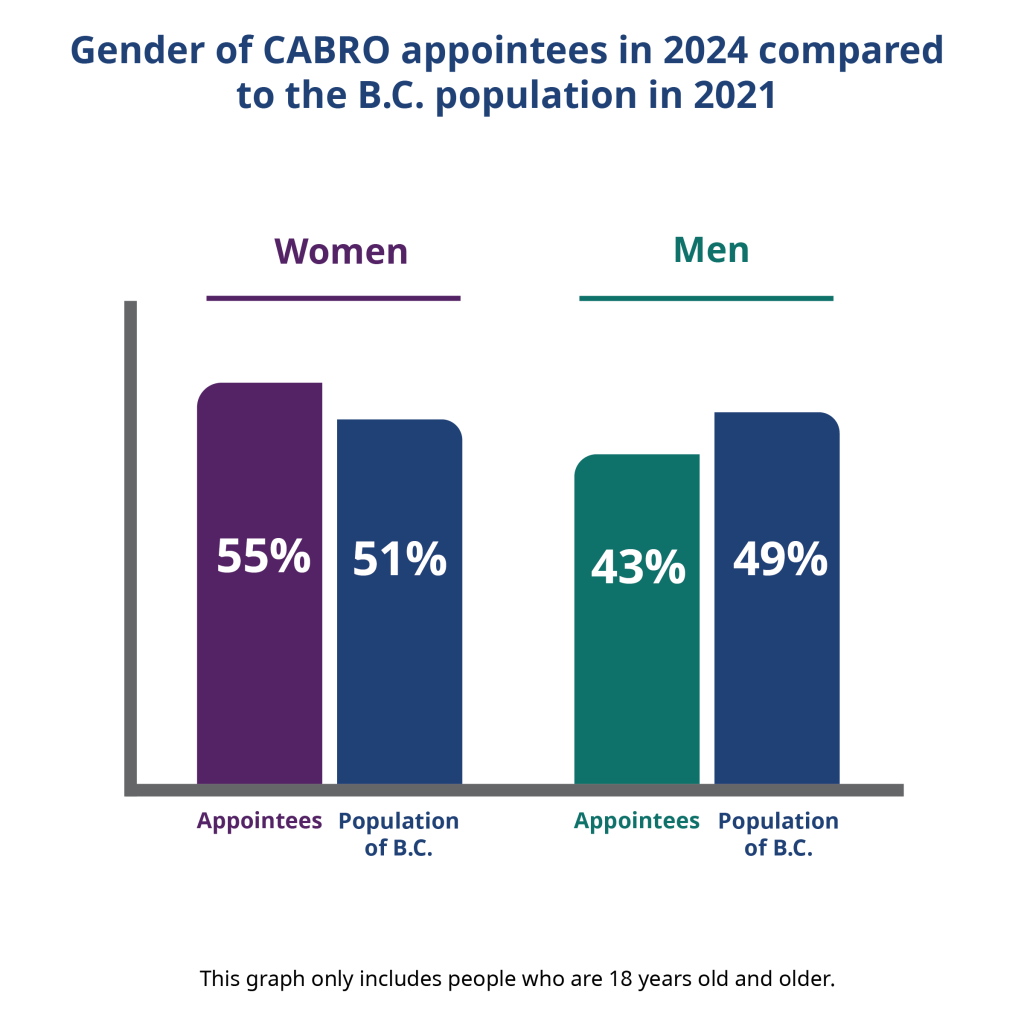
Gender
42.6% identify as men, 55.4% identify as women
Compared to everyone else in the sample, appointees identifying as women were:
- More likely to identify as First Nations
- More evenly distributed between 35-54 and 55+ age groups
- More likely to be caregivers for a child under 18
- A small number of people identified as non-binary. To protect their identity this number is not disclosed.
A note on using population data
The research team used Census data to compare representation rates to B.C.’s adult population. While this helps to give some insight into diversity, it also assumes that everyone in the population is eligible to apply to a CABRO position.
In reality, the number of eligible candidates is smaller as positions may require that appointees have previous experience, education, training or the ability to travel for the role. This means some individuals may be excluded from applying, particularly caregivers and those in rural and remote communities.
Years of colonial and racist policies such as the Indian Act, residential schools and the Chinese head tax have also limited population growth and displaced multiple generations of Indigenous and racialized people.
The effects of these policies and actions continue to impact the size of Indigenous and racialized communities in B.C. and have led to a lack of trust in the data collection process. This means that some individuals or communities choose not to participate in the Census.
Census numbers may not offer a true comparison for assessing representation. The way that Statistics Canada records data means some racialized people are not properly represented if they identify with more than one racial group. For example, if someone identifies as both “White” and “Latin American”, they would not be recorded as part of the “Latin American” group.
This results in routine undercounting of Indigenous and racialized people and may impact access to services, funding or opportunities if decisions are made based on population data. In 2021, Statistics Canada estimates that just over 10% of people living on reserves in British Columbia were not included in census counts.
Statistics Canada is carrying out ongoing engagement to reduce harms and improve the data collection process.

Next steps
It’s clear that some groups are experiencing barriers to being appointed to B.C.’s agencies, boards or commissions. These findings provide a baseline that we can use for future comparisons to help us understand how representation is changing over time. With this information, CABRO will also be able to remove barriers and improve representation.
CABRO will continue to carry out a survey every two years. The results will help us track progress toward our goal of reflecting B.C.’s diversity on our agencies, boards and commissions. We’ll also work in collaboration with underrepresented communities to determine how to address barriers.
We acknowledge that these statistics do not show the full picture. Beyond this, it’s important to understand how appointees from equity-deserving groups are distributed across boards, what positions they occupy and whether they feel supported and empowered in their roles.
For future surveys, CABRO will gather information on people’s experiences as appointees and look into a more detailed analysis at a regional and board level. This will help us to identify where we can do more to support those who are applying for and working in these roles.
Learn more
Read the report to learn more about this research project, including further information about the survey and detailed findings about board appointees.
Interested in applying for a B.C. board, agency or commission position? Visit the CABRO site to view current opportunities and apply.
